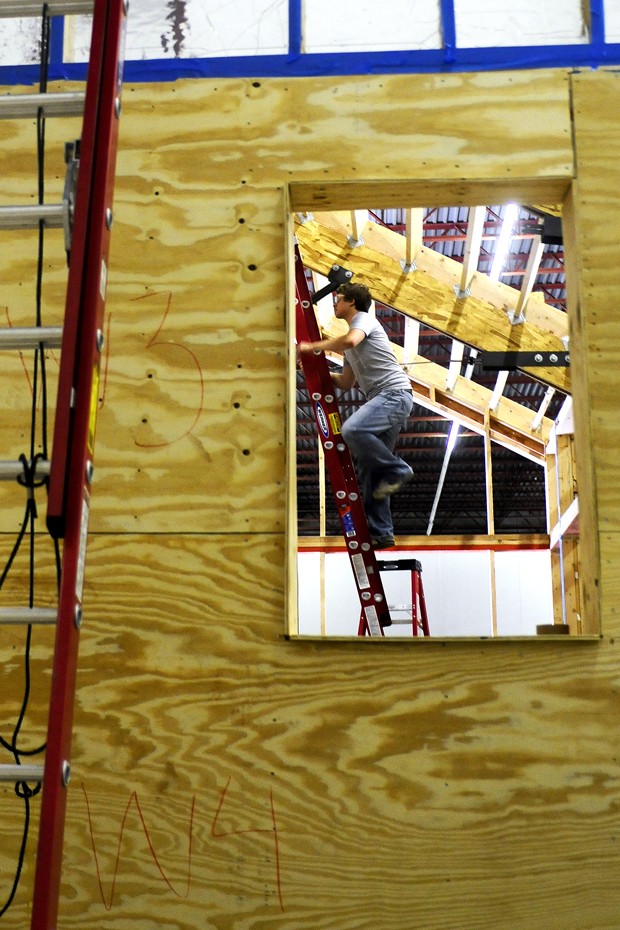After almost two years of planning and executing the design and architecture of a sun-powered house, a group of University of Minnesota students is nearly ready to move the product to the National Mall in Washington, D.C. , for an international competition of solar houses this October. The University was one of 20 colleges selected out of 40 applicants to present a house at the fourth biennial Solar Decathlon Competition . This is the first year the University will be a part of the contest. Work began in October 2007 when a few students attended the 2007 Solar Decathlon Competition in Washington, D.C. Shengyin Xu , student project manager for the team, was one of these students. âÄúWe took two Priuses out there,âÄù she said of the eco-friendly trip. Xu said from there, a few of the students and some faculty members wrote a preliminary plan of a house that focused on what resources the University had for the project, which was the application to be a part of the competition. One goal of the competition is to make the house a âÄúZero Energy Home ,âÄù or a house that produces and consumes an equal amount of energy; energy must also come from renewable sources. âÄúWeâÄôre really trying to demonstrate how solar [energy] can work in a home,âÄù said John Horst, spokesman for the Department of Energy (DOE) , which is a major sponsor of the competition. Horst said the DOE also sponsors the event to encourage young people to pursue careers in science and engineering and to acquaint them with the opportunities solar energy presents. âÄúThe idea is to think about the ways we can use our energy that will explore benefits of how these technologies can help us reduce energy in a home but maintain our current lifestyles,âÄù Horst said. Xu said 13 teams , each focusing on a particular aspect of the houseâÄôs design and structure, were formed through a combination of faculty references and students hearing about the project and getting involved. The teamsâÄô focuses range from architecture and construction to communications and interior design. Xu, a third-year architecture and sustainable design graduate student, said each of the 13 teams varies in size, from just two students to 15. Because of the rush to complete the house, Xu, like others involved, has spent a lot of time at the construction site. âÄúLately IâÄôve just kind of brought my computer, worked here, had meetings here,âÄù she said. Construction manager Craig Hohensee has perhaps put in the most work over the summer, as work days have become progressively longer since construction began on April 1. âÄúThings are coming together slowly. In the summer, the biggest difficulty is getting a consistent supply of labor,âÄù Hohensee said. âÄúThe ones that are here every day, you get to know them on a little more [of] a personal level, which is important I think.âÄù Hohensee said the students that show up day-to-day to help with construction are an even mix âÄî the majority of those that do help consistently are in the construction management program at the UniversityâÄôs College of Continuing Education (CCE) , which Hohensee completed in December. Hohensee called the current workload âÄúgrueling,âÄù explaining that most days on the construction site last until 9 or 10 p.m. While the finish line (the competition in Washington D.C.) is not until October, the house will be on display on Aug. 14 at the UniversityâÄôs Equine Center near the State Fairgrounds . âÄúThat will give us some experience with the tours,âÄù Hohensee said of the showing in August, which is arguably a practice run for both the team and the transport of the house itself. âÄúWeâÄôre going to be running all the assembly [and] procedures exactly the same [as for the competition],âÄù said Jake Wollensak , a second-year architecture graduate student who is the Logistics team leader. Wollensak explained for the trip to Washington, D.C., the house will be broken into six pieces, three base pieces and three roof pieces. Each base and roof piece correspond, so the six pieces will be broken into pairs and transported to Washington on three flatbed trucks, along with a fourth flatbed truck for any leftover parts. Two additional trucks will carry furniture and building equipment. Wollensak said the houseâÄôs size is both an inconvenience to transporters as well as an advantage for the competition. âÄúThe maximum square footage for one house is 800 square feet, and ours is 799 [square feet],âÄù he said. While the houseâÄôs size will be larger than most, Xu said the budget the team allotted for the project is âÄúin the middle of the packâÄù in comparison with other teams. Ann Johnson , the teamâÄôs project manager, said the $1 million budget began with a grant of $100,000 from the Department of Energy that the team received when it was accepted into the competition. Xu said the remaining money came from construction material and monetary donations from companies such as paint company Valspar and technology companies Honeywell and 3M . Johnson said the team is still seeking $200,000 to reach the $1 million mark by soliciting donations from engineering and architectural professional organizations, as well as from larger companies like Target and Best Buy . At the Washington D.C., competition, from Oct. 8-18 , the teamâÄôs house will be judged in 10 categories ranging from the houseâÄôs lighting design to its home entertainment. Solar Decathlon spokesman Tom Welch said the competition draws as many as 100,000 spectators each year and that lines can get to up to a block long for tours of the houses. As for after the competition, Wollensak said the team has not decided what to do with the house, although selling it is always an option. He said the retail value of the house would be approximately $400,000-$600,000. Johnson said that the University will apply for entry into the 2011 Solar Decathlon competition this September.











